by Alison Hugill // May 12, 2023
This article is part of our feature topic Aging.
At the beginning of this year, Canadian artist Liz Magor published her latest book ‘Subject to Change,’ in which she shares some of her own writings about her work. Over the last five decades, she’s been honing a particular way of working that is absent of textual analysis or planning, and minimal in concept and direction. Starting her works this way, she hopes to access a phenomenological side of her practice, and she only uses writing to process the work conceptually after the fact. Speaking with Magor on the occasion of her opening at Focal Point Gallery in the UK this spring, she explains: “If art currently tends toward being referential, I’ve always wanted my work to be about ‘being’ rather than knowledge.”
The “being” in question in Magor’s work is most often not human, nor does it have any pre-conceived “essence.” Rather, she collects discarded materials—from textiles to stuffed toys to housewares and other personal belongings—and puts them into relation with one another in her sculptural installations. By choosing materials that are significantly used, aged and bordering on obsolescence, Magor pushes viewers of her work to explore our own consumption of “things”—how we relate to objects over time and what happens when they are no longer relevant in our lives.
At Focal Point Gallery, Magor’s exhibition ‘The Rise and the Fall’ presents works made in the last five years. Nevertheless, she’s had a long career that began in the 1970s, and recognizes the privilege of being able to work as an artist for so long. For Magor, intuition is gained with age and her practice becomes more perceptive with time. In our conversation, we touched on aging—both personal and material—and the incongruities inherent in decisions around what is deemed worthy of preservation.
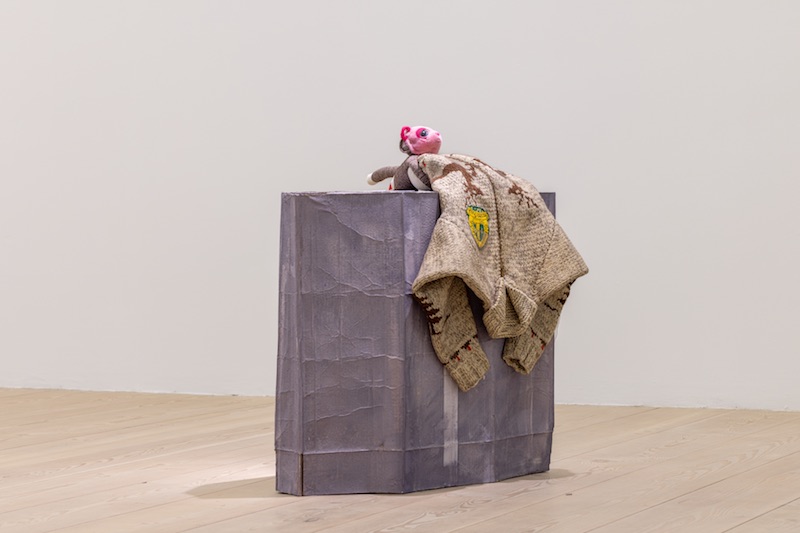
Liz Magor: ‘Oilmen’s Bonspiel,’ 2017, Focal Point Gallery installation view // Photo by Anna Lukala, courtesy of the artist and Focal Point
Alison Hugill: In your work, you are interested in the “lives of discarded objects” and their “emotional resonance.” How do you see these objects in terms of lives lived, outside of human intervention?
Liz Magor: For a long time, my work has been about the material world that I walk through, primarily the built or manufactured environment, as opposed to the natural material world. I’m interested in the material things that we produce and live with and use for short or long periods of time. They may go in or out of fashion, or deteriorate. There’s a variety of reasons that we let go of them, but they persist even when we’ve discarded them. They don’t simply disappear because we’ve lost interest in them.
I don’t use them as portals into the lives of their owners. I am interested in the life of the object now that it is no longer in a team situation with a human, because there is this idea that we are the bosses of them and that they are our actors. But if you look at how much we discard, I would say that the material world is actually directing us. It’s way bigger than we are.
We have a full spectrum of ways of relating to these materials: from the museum, where we preserve and look after them for as long as possible, to recycling, to just plain throwing them out. We are trying to manage this material world even when we are done with it.
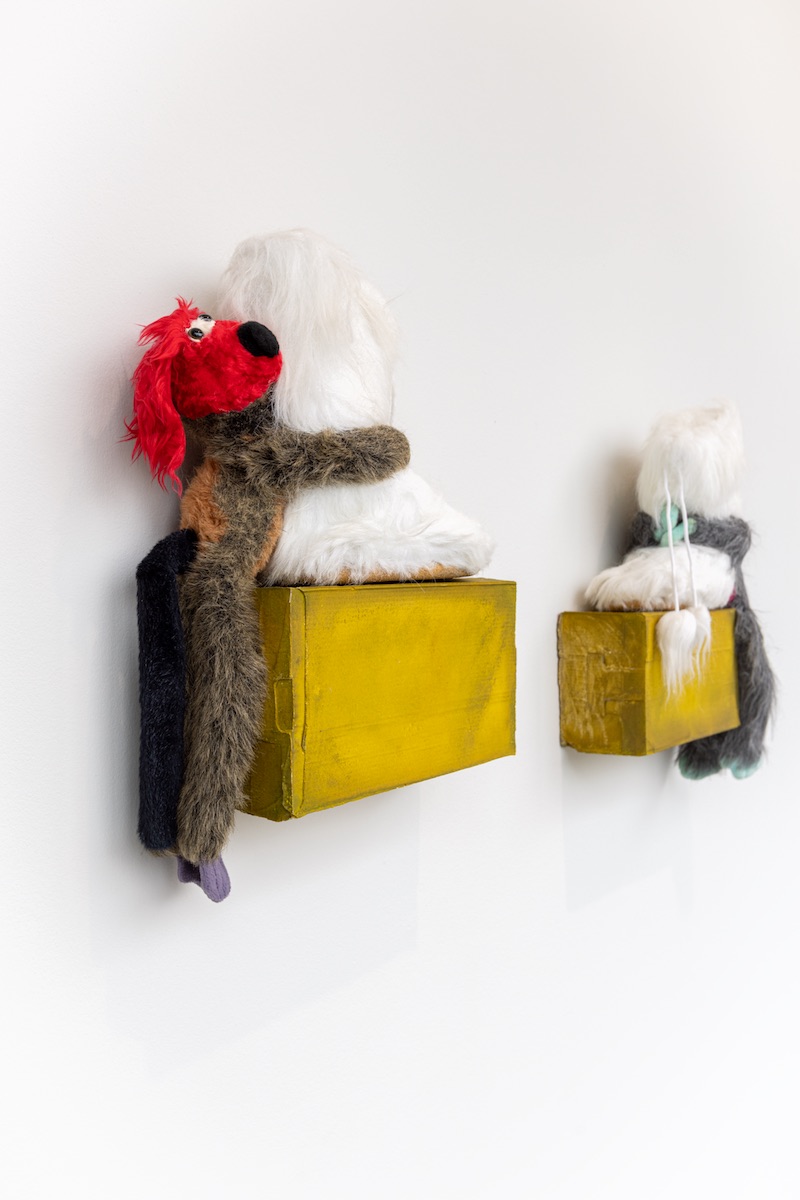
Liz Magor: ‘The Boots,’ 2017 // Photo by Anna Lukala, courtesy of the artist and Focal Point Gallery
AH: Where do you source your found objects and what significance do they have for you?
LM: I don’t pick up museum quality things. I barely even pick up recyclable things. I am on the other end of the spectrum, where the things are hovering around obsolescence. We pay less attention to these items on the whole, as we wait for them to die. So I pick them up and bring them into the studio: things ranging from garments that I find in a second hand store, to stuffed toys or tools or packaging. I consider them empty at that moment: they’ve been discarded and no longer have a relationship to humans. I want to let them grow into themselves, so I put them into relationship with other objects that they didn’t know before.
AH: You’ve called them “zero things.”
LM: Yes. They have little importance when I find them. But sometimes they do still have some allure—a hook or a colour or a shiny element. There’s some undiagnosed line between objects and ourselves. They call our name in some way and we bring them into our lives. Sometimes that allure is still there and I try to find that.
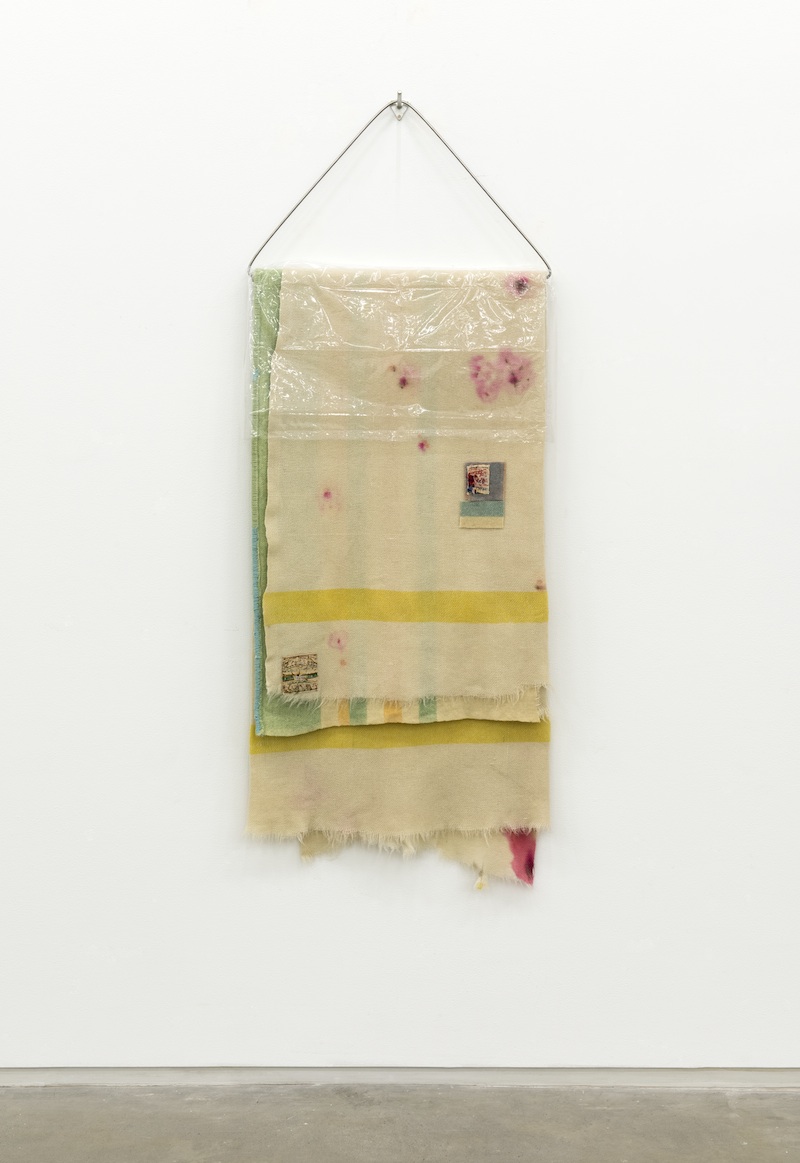
Liz Magor: ‘Alberta/Quebec,’ 2013, wool, fabric, thread, dye, plastic, metal and wood, 134 x 54 x 8 cm // Photo by SITE Photography, courtesy Catriona Jeffries, Vancouver
AH: You have said elsewhere that some old blankets you acquired for your dogs ended up being incorporated in your work because they spoke to you in some way.
LM: In terms of the language, I’d like to leave out the idea that they “speak to me” because, in fact, I am doing all the work. The objects are manufactured with certain characteristics, but then I do all the work. That’s what’s interesting about humans: the projection of our own narratives onto objects.
With the blankets you mentioned, they were really old but they were still offering themselves somehow: still on hangers with a price tag. Some of them were almost a hundred years old. That is persistent. I doubt that I will live to be a hundred years old. Many of them were from the 50s, when wool blankets were popular. There’s a history of retail and trade agreements in these blankets, too. But in my work I don’t try to use objects to tell a history, in fact: the opposite. I try to read a phenomenology of the subjective encounter with the objective world, that is outside of language. I don’t see the objects as signifiers for deeper histories, but as things that have qualities and characteristics that I haven’t known, because I haven’t spent time with them. They’ve raced through my life so fast that I haven’t considered them from a non-utilitarian angle.
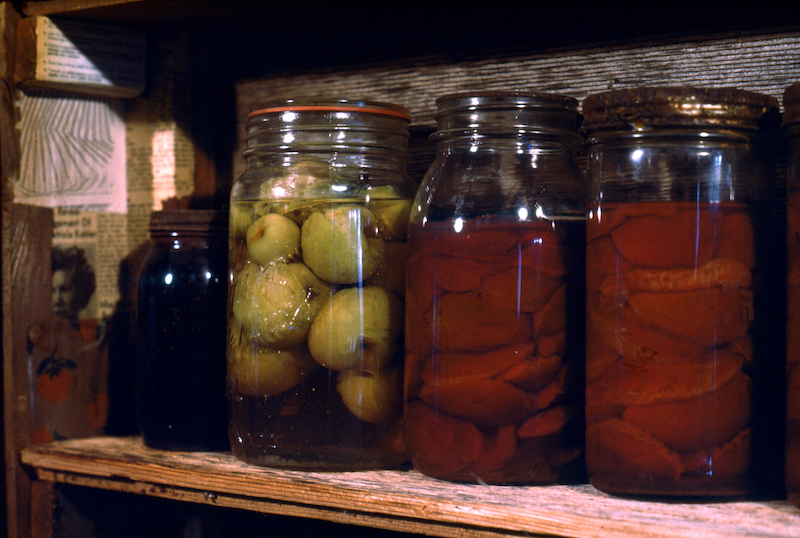
Liz Magor: ‘Time and Mrs. Tiber,’ 1976, wooden shelf with jars of preserves, recipe box, forks, glass tops, rubber sealers, metal lids, cardboard boxes, enamel cup, tin can, 214 x 91 x 32 cm // Courtesy Catriona Jeffries, Vancouver
AH: Let’s talk about an older work, ‘Time and Mrs. Tiber’ (1976). Through an encounter with literal preserves, you considered different levels of preservation: “the desire to extend the life of a fruit for the season, to the desire to hold it for a lifetime, to the museum’s desire to maintain it in perpetuity.”
LM: This might be the work that set me on my path. In the 70s, I was just figuring out how to be an artist. I came across this house that had fallen down, in a very rural setting. There was only one wall standing. On that one wall were these jars of fruit that had been preserved in the 40s and early 50s. They were about 25 years old when I found them, and so was I, by the way.
We are very conscious of time when we are handling fruit: you can barely keep fruit a week in your house. But here they were, still edible. When I was younger I had a very simplistic concept of time that only related to my life, my day, my progress on the planet. When I saw the fruit, I realized that it was way more complex. I fetched them out and turned them almost literally into a sculpture, saying: “look at this.” I made a shelf, out of wood that I sourced from the same place.
It was a time when I could be very literal in my work. I could take things from the world, put them through a process, but not abstract them. I was looking for something more complicated than their essence. Maybe there is no essence.
AH: You’ve had a 50-year career already. How have things changed for you since the early days and what are some take-aways thus far?
LM: Intuition, which is the result of simply working for a long time, is a beautiful resource for older people. I think you can only get it through aging, and that is if you can keep going as an artist, and I don’t think that’s easy for a lot of people, for a variety of reasons. It’s hard to have a complicated life as an artist—you’re making things out of thin air and you really need to bear down and pay attention. In my field, intuition is a major tool in the work, so it’s a big bonus.
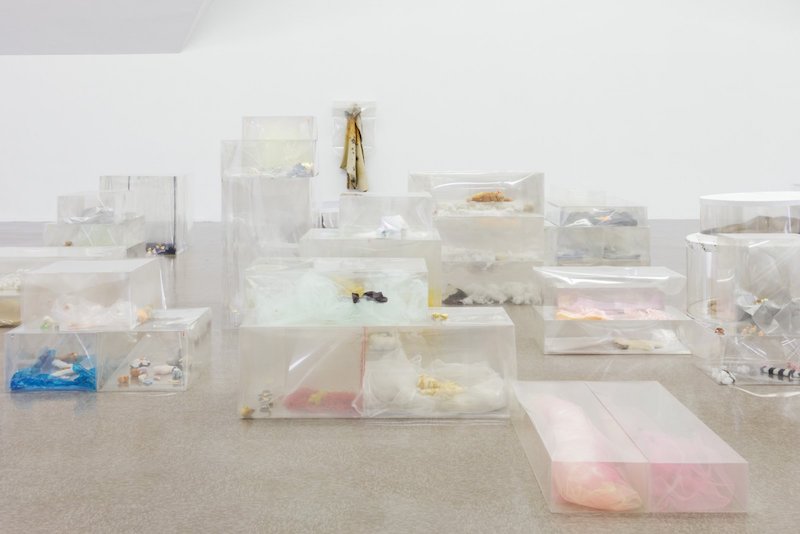
Liz Magor: ‘Pet Co.,’ 2018, polyester film, textiles, paper, stuffed toys, rat skins, mixed media, 112 x 518 x 396 cm, Installation view, ‘BLOWOUT,’ Carpenter Center for Visual Arts, Cambridge, USA, 2019 // Photo by Useful Art Services, courtesy Catriona Jeffries, Vancouver
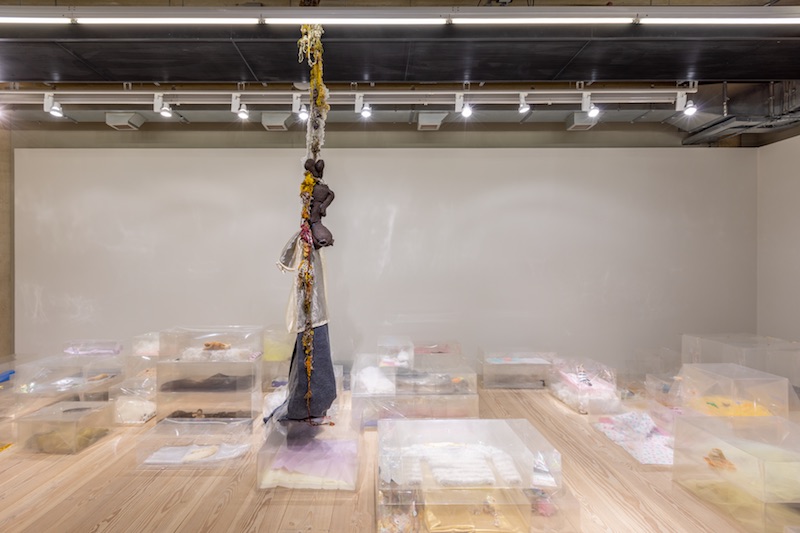
Liz Magor: ‘The Rise and The Fall,’ 2023, installation view // Photo by Anna Lukala, courtesy of the artist and Focal Point Gallery
AH: Can you tell us about the exhibition you’re currently presenting at Focal Point in the UK?
LM: I made a work called ‘Pet Co’ before the pandemic sometime. It was very physically complicated. I did the DAAD residency in Berlin in 2017/18 and I went to [the art supply store] Modulor everyday because it was near my studio. I found a clear sheet material called mylar, which is very flexible like thick paper. I did all kinds of folding, to see if I could give this floppy material any structural integrity. I made these clear containers, which looked like plinths if I stacked them. So the objects inside could be raised up from the floor to eye level. I made about a hundred of them in different sizes. In Berlin, I became fascinated by the stuffies that I found in flea markets. They were way better than in North America; they had a kind of nobility to them. I filled the boxes with stuffies that were coming apart.
I do a lot of mould-making, so many of the objects I bring into the studio aren’t just shown as they are. I make a mould of them and cast them in new materials and colours. There’s a work in the exhibition with a big lion that was a kid’s toy that I’ve taken apart and cast in rubber. It has a beautiful mane of white hair.
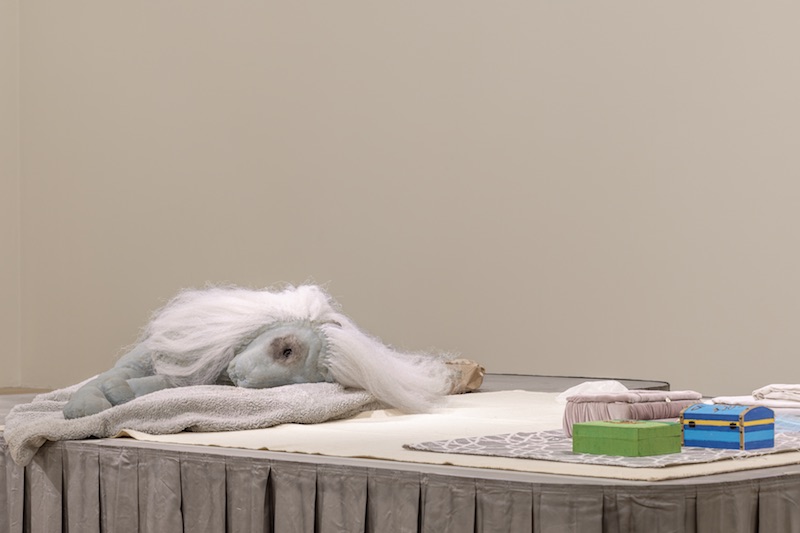
Liz Magor: ‘Coiffed,’ 2020 // Photo by Anna Lukala, courtesy of the artist and Focal Point Gallery
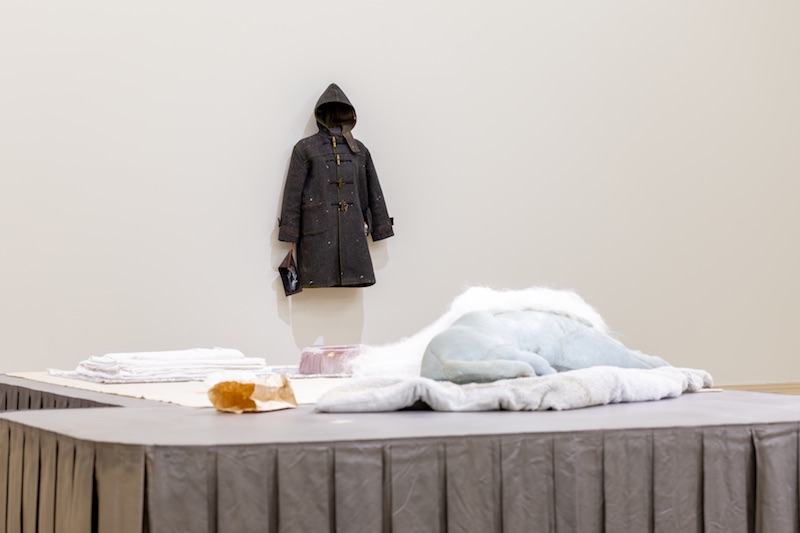
Liz Magor: ‘The Rise and The Fall,’ 2023, installation view // Photo by Anna Lukala, courtesy of the artist and Focal Point Gallery
AH: You are enhancing the status of these found objects through your artistic process and then eventually through exhibition.
LM: Someone, about 50 years ago, gave me a beautiful box and said “don’t open this until you get home.” It was full of antique stuffed birds. I kept them as beautiful things for a long time, and then I decided to elevate them into sculpture to extend their lives. Art, if it is collected, goes into a stream of preservation. Most of the materials I use are not, in themselves, on a path to preservation. But if you organize and get it placed, it can exist in a different kind of time zone.
Two of the works in the exhibition have these birds in them. They are held in elevated packaging situations, where I made a mould of cardboard and cast it in this hard material I use. So you’re looking at this crappy cardboard box, but it’s holding this exquisite bird that’s in a plastic bag. There’s a lot of push and pull between the quality of the bird and the quality of its surroundings.
There’s also a duffel coat, called ‘Perennial’ (2021), that’s been around the block. I valorized every bit of damage on the coat. Every little hole or thread that’s been pulled out, every missing button, every tear has been accentuated in a decorative way.
In the end, after we leave with all our of vanities and all our passions, these things are still there.
Exhibition Info
Focal Point Gallery
Liz Magor: ‘The Rise and the Fall’
Exhibition: Mar. 8-June 10, 2023
fpg.org.uk
Elmer Ave, Southend-on-Sea SS1 1NB, UK, click here for map




















